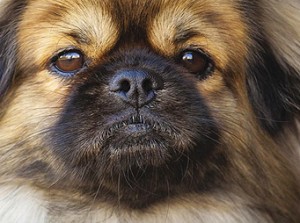Breed Priorities – The Tibetan Spaniel
264 – October, 2017
by Nikki Riggsbee
This discussion is not intended to promote fault or part judging. One should always evaluate a whole dog as a package. However, one develops and improves his picture of excellence by deciding what to emphasize for each breed. They say that evaluating dogs is a matter of what you will forgive. Having priorities can help with that process.
 The Tibetan Spaniel is from Tibet, bred and owned by Buddhist monks in the Himalayan Mountains, known as a breed for more than 2000 years. But it isn’t a spaniel. That part of the name came from a translation of a French word for a companion dog.
The Tibetan Spaniel is from Tibet, bred and owned by Buddhist monks in the Himalayan Mountains, known as a breed for more than 2000 years. But it isn’t a spaniel. That part of the name came from a translation of a French word for a companion dog.
Tibetan Spaniels first arrived in England at the end of the nineteenth century and to the United States in 1966. They were recognized by AKC and put in the Non-Sporting group in 1984.
We found thirteen Tibetan Spaniel breeder-judges to invite to participate in a survey on their breed’s priori- ties. We added the parent club breed mentors to the group. Twenty agreed to take the survey, and twelve completed surveys were received. Most of those who returned surveys were the breeder-judges. Only two of the breed mentors contributed.
The experts have been in Tibetan Spaniels twenty-nine years on average. The judges averaged more than sixteen years judging the breed. More than half have judged their national specialty, and many have judged other Tibbie specialties as well.
Tibetan Spaniel Virtues
The survey included a list of virtues from the breed standard. The experts were asked to prioritize the characteristics from most important to least important. The list below is in order by the average rankings of the experts.
1. Muzzle medium length, blunt with cushioning, chin shows some depth and width
2. Head small in proportion to body
3. Slightly longer from point of shoulder to root of tail than height at withers
4. Apelike expression
5. Eyes dark brown, oval, medium size, set fairly well apart but looking forward
6. Level back
7. Ears medium size, pendant, well feathered, set fairly high
8. Tail set high, richly plumed, carried in gay curl over back when moving
264 – October, 2017
Short URL: https://caninechronicle.com/?p=133751
Comments are closed











